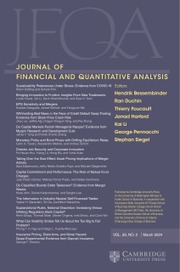No CrossRef data available.
Article contents
Default Costs and Repayment of Underwater Mortgages
Published online by Cambridge University Press: 11 July 2025
Abstract
We explore an overlooked phenomenon in mortgage markets: repayment of underwater mortgages. Using a sample of mortgages terminated between 2007 and 2016, we show that such repayment indeed occurs, and that it is affected by the same factors commonly used in studies of default: the magnitude of home equity and the borrower’s credit score, which captures default cost as well as liquidity. A novel insight is that underwater repayers, unlike most defaulters, are not liquidity constrained, providing a much cleaner environment to study default costs. We estimate lower bounds on these costs. Our results indicate that default costs are substantial.
Information
- Type
- Research Article
- Information
- Creative Commons
- This is an Open Access article, distributed under the terms of the Creative Commons Attribution licence (http://creativecommons.org/licenses/by/4.0), which permits unrestricted re-use, distribution and reproduction, provided the original article is properly cited.
- Copyright
- © The Author(s), 2025. Published by Cambridge University Press on behalf of the Michael G. Foster School of Business, University of Washington
Footnotes
We thank George G. Pennachi (the editor), David Low (the referee), Kris Gerardi, Jim Kau, Jack Liebersohn, Mike Reher, Tim Riddiough, and seminar participants at the 2024 FSU-UF Critical Issues in Real Estate Symposium and the 2024 AREUEA National Conference for helpful comments. All errors are our own.

